
Lab Summary: Grain II
Reporters: Samantha Zimmerman, Rahim Hamid, Marta Kondratiuk.
Data drawn from reports by: Ben Scott-Lewis (group A), Amelie Cook (B), Ann Beimers (D), Jake Oberg (E), and Eila Planinc (F).
Introduction:
This week in Experimental Archaeology, we continued our exploration into the making of bread in accordance with ancient texts such as Cato’s account of bread recipes. There was a variety of bread made by each group. Groups A, B, C, and D handled libum, savillum, (both cheese breads), unleavened salt-flour-water loaves, and sourdough breads; groups E and F made maza, porridge and fry bread.
This lab acts as a look into the theme of everyday life in the ancient world. Agriculture and grain comprised the occupations and diets of the vast majority of people who lived around the world, and so being able to engage in the processes that approximated the labor and products involved was informative and brought us to a deeper understanding of bread-making and the effort that it took to make this staple of ancient (Greco-Roman specifically) diets.
We all additionally had the privilege of performing all the cooking in pretty ideal weather conditions and receiving sourdough bread from Morgan Morton. Sampling the different types of bread gave each of us a diversity of the breads that could be made from the textual sources we had read and eating the bread together around the fire, talking and comparing our findings, was definitely a highlight of the lab as a whole.
Group A
The libum was made with an egg, whole grain flour, feta (about twice as much as the flour) and water. Despite cooking for 40 minutes, even the smaller loaves (the loaves were divided into one larger and several smaller loaves) did not cook properly which was attributed to the sheer density of the cheese bread. It was still edible and some members of the group enjoyed the taste.
The unleavened loaf was made using simply flour, water and salt. The bread was noted again as being quite dense and accordingly took 50 minutes to cook. In comparison to the prior bread, it was lighter. It was additionally noted as being quite plain, but was speculated to be tolerable over long periods of time when paired with other foods or toppings.
The final bread to be made was the sourdough. It initially used the same materials as the unleavened bread but with the addition of bacteria and yeast. This bread was much lighter and airier comparative to either of the prior two breads, and was noted as tasting much better.
In terms of time, the unleavened loaf took the longest to cook at 50 minutes total, followed by the libum at 41 minutes and finally the sourdough which took 34 minutes total to cook.
Group B
Group B used the same measurements to create their libum as Group A did in terms of the ratios and exact amount of flour, feta, eggs but differed in that they used 14.7 grams of water as opposed to the 37 grams used by Group B. This change was noted as being necessary due to the initial mixture being too dry otherwise to knead into bread. Additionally, Group B used sifted bread flour instead of the whole grain flour Group B used. There were once again issues with the dough not cooking all the way through, which was put down to issues regarding the coals and fire that were used to cook and heat the oven used. The libum, despite this, was still noted as tasting good.
The unleavened bread was made with the same red fife flour, combined with water and sea salt. There was much more kneading involved in the making of this loaf than of the libum, and it was also noted as being quite dense and salty to the taste, which was interesting as the group recorded that they only used 5 grams of sea salt for 250 grams of flour and 175 grams of water. The texture in particular however was reported as being much better than the libum.
The sourdough was put into preheated pots and cooked the same way as Group A’s sourdough. Upon cooking, it was once again noted as being much lighter and tastier than either of the two prior breads.
In terms of time, the unleavened loaf took the longest to cook at 49 minutes, followed by the libum at 47 minutes and finally the sourdough which took 35 minutes to cook.
C/D:
(No data from group C at time of writing)
Both group C and D prepared a modified version of the libum, called savillum, from a recipe of Cato. Compared to the libum, the savillum uses a larger feta:flour ratio (about 5:1, compared to 2:1 for the libum. The savillum also uses honey; the precise amounts for each are given in Table 1.
The procedure for forming the loaves was similar to the libum: fresh (Greek-style) feta cheese was crumbled and kneaded together with the flour, honey, and egg to form a loaf. Each group cooked their loaf for about 40 minutes in a Dutch oven without success; the loaf did not cook through. We concluded that the loaves were too dense to cook through given their size. In a second attempt at the recipe, we would have formed much smaller loaves – roughly chicken egg-sized.
The groups also prepared a flour-water-salt bread without leavening and baked a sourdough loaf that used the same ingredients. The unleavened bread was prepared with a ~5:3 mixture of flour and water and a large dash of salt, then kneaded for ten minutes and baked for ~30 minutes. The dough for this loaf was very easy to work with, and each group decided to shape their loaf, using designs like a long braid or a heart. To me, this recalled the use of ceramic bread molds by the Romans that featured detailed designs that imprinted the top of the loaf. The resulting bread was quite dense, but thoroughly cooked without burning and tasty.
The final bread loaf was a sourdough, which had been prepared and risen beforehand. The ingredient amounts of flour, water, and salt, however, were the same as for the unleavened loaf. Since we did not prepare or knead this bread, we can only report that it cooked evenly, being in the oven for about 30 minutes. The resulting bread was light, springy, and had a distinctive sourdough taste; students preferred it significantly to the other recipes.
A/B/C/D Wrap-up
This lab featured three takes on a basic flour+water bread pattern. The savillum and libum would have been luxury breads given the amount of cheese in the recipe. They would also have been extremely rich! While we had success forming these breads into loaves and kneading them, we struggled to cook them all the way through owing to their density. This suggests that they would have been formed into much smaller loaves (more like dinner rolls) or that they simply had to cook for several hours.
The unleavened bread turned out quite well and was easy – and quick – to prepare. We can easily imagine how it could form the core of a person’s diet. Finally, the sourdough bread, while somewhat time-intensive, was a significant taste and texture improvement (for us) over the unleavened version.
| Recipe: | Flour: | Water: | Salt: | Feta: | Egg: | Honey: | Cook time: |
| Libum | 327g | 15g/37g | — | 655g | 1 | — | 41/47 min |
| Savillum | 165g | —– | — | 818g | 1 | 82g | 37 min |
| Unleavened bread | 250g | 175g | 5g | — | — | — | 49/50 (group A/B) or 33 min (D) |
| Sourdough | 250g | 175g | 5g | — | — | — | 30-35 min |
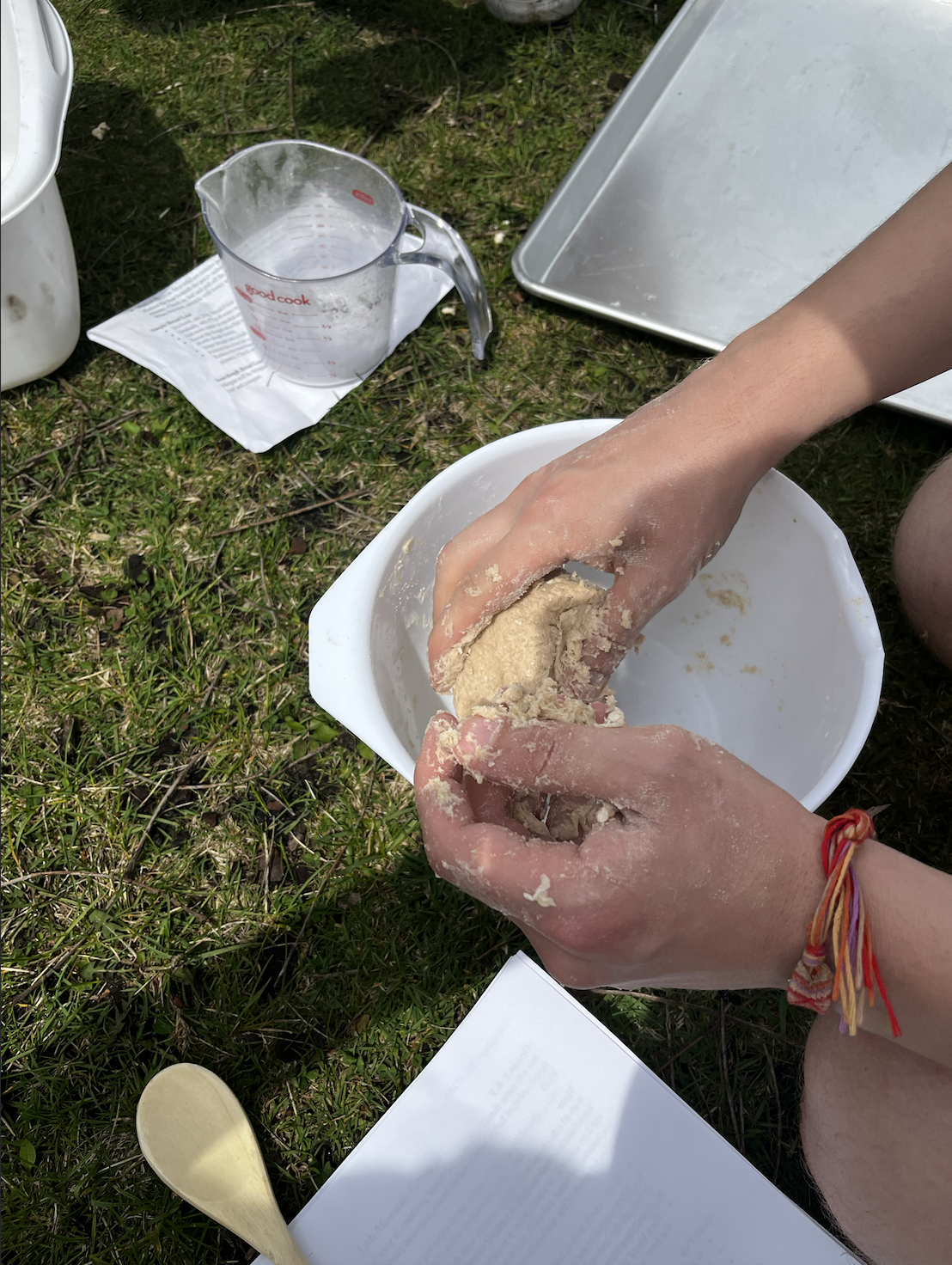

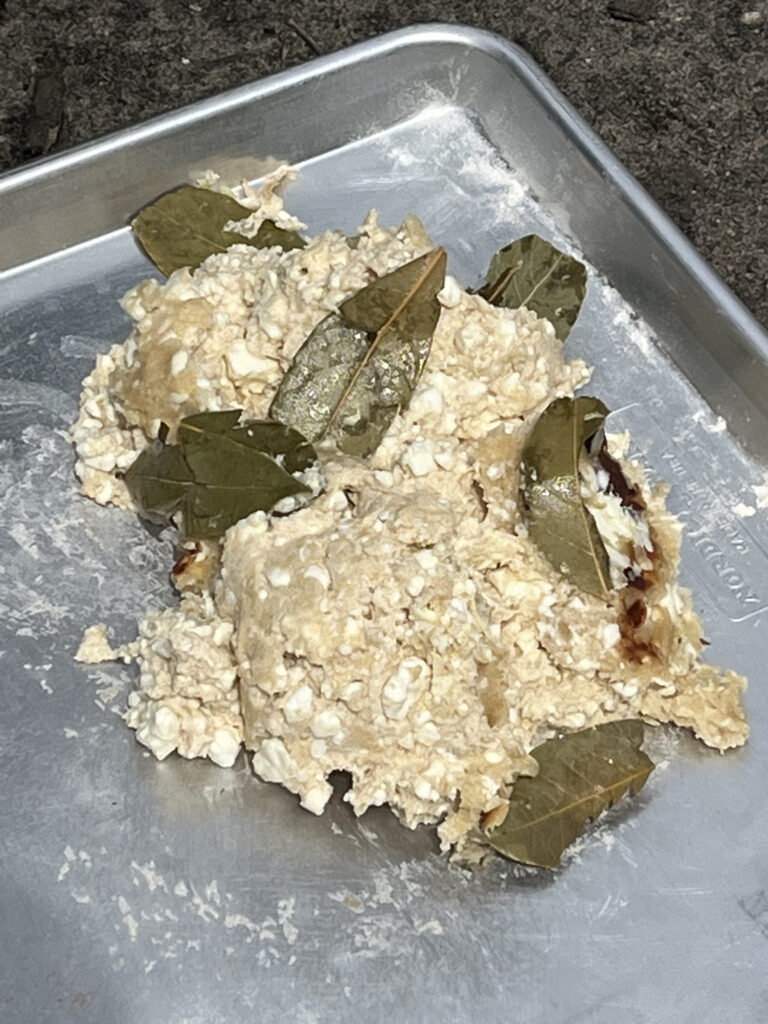

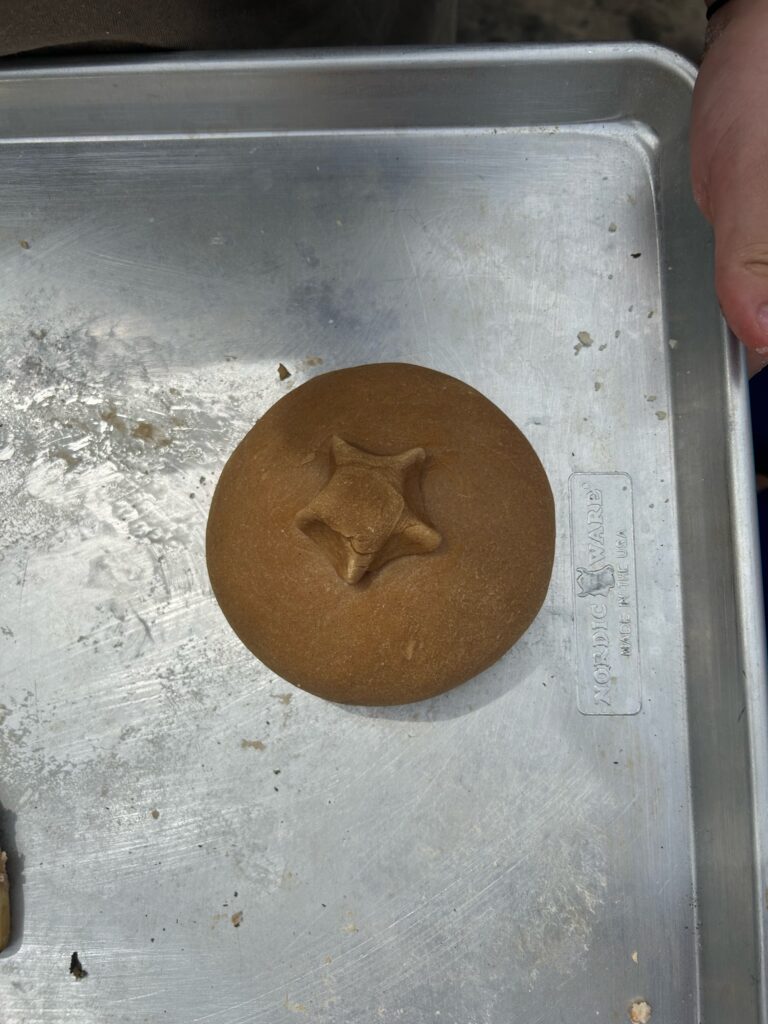
E/F:
Groups E and F were tasked with preparing a range of grain dishes outside of the traditional loaf in order to learn more about the wider ancient gastronomic tradition. Each group attempted to make maza, Punic puls, and frybread.
1: Maza
The process of cooking maza consisted of three steps: roasting barley, grinding it, and shaping it with the help of water, oil, and honey into edible chunks.
Roasting
| Group | Initial Weight of Barley (g) | Time Until Fully Cooked (min) |
| E | 257 | 23 |
| F | 496 | 28 |
Both groups report a strong “nutty” smell in the first 7–10 minutes of cooking similar to burning popcorn. After the cooked barley cooled off, people were eating full grains, describing their taste as “wholesome” and, like the scent, resemblant of a popcorn kernel.
Group F roasted significantly more barley than Group E. It was predicted by our professor that more barley on the pan would result in quicker roasting, however, in our case, it was the opposite. It is important to note that cooking anything over an open fire gives one less control over the temperature, so Group E might have been working with stronger heat.
Grinding
Every group had to do 5 minutes per member of grinding the barley on the metate. Group E had 3 members present, and Group F had 4, therefore each group did, respectively, 15 and 20 minutes of work. Neither group measured the weight of the flour as there was no sifter and the whole grains lost in the mixture, even after meticulous picking out and hand sifting from both groups, would tamper with the measurement.
Shaping
Group E reports adding 3 dashes of water, a little bit of oil, and some honey. The flour ended up being good for 8 pieces of maza; they held together with relative stability. Group F, on the other hand, describes the process of shaping as “annoying,” saying that they added, “a lot of water, honey, and oil in an effort to get things stuck together, but it never really worked.” In the end, the group was successfully able to construct 7 balls of varying sizes, however, they would keep crumbling as they were being eaten. It is unclear what the two groups did differently because the measurements for the additional ingredients were eyeballed in both cases. For any experimental archaeologists looking to repeat this experiment, I can only advise the wonderful method of trial and error.
Maza tasted much like granola bars and could theoretically last a long time before going bad. Both groups could see the appeal of this convenient and nutritious snack.
2: Punic Puls
| Group | Weight of Feta (g) | Weight of Farro (g) | Weight of Honey (g) | Amt of Eggs | Amt of Water | Time Until Fully Cooked (min) |
| E | 484 | 163 (dry) | 140 | 1 | — | 30 |
| F | 490 | 163 (dry) | 82 | 1 | ¼ cup | 16 |
Who knew water could be so crucial? When making their Punic puls — a kind of ancient porridge — Group F added a quarter cup of water before placing their mixture of feta, soaked farro, honey, and egg on the fire. This decision made the grains in their dish soften quickly and caused the texture to become softer and runnier.
Contrastingly, Group E neglected to add water as it was the optional part of the recipe and they wanted to experiment with adding it later. After 15 minutes over the fire, it became clear that the grains were not softening the way they were meant to. After a ten-minute break from the direct heat of the fire, the pan was placed back onto the grate with an addition of water but ended up with a more hummus-like consistency in the end.
Nonetheless, both groups came out with a delicious product (which tasted even better on bread) but it turned out that water was necessary for achieving a porridge-like consistency.
3: Frybread
For the final meal of the day, both groups quickly made some frybread from premade sourdough loaves provided by a local bakery. The consistency of the dough was sticky but getting some flour on one’s hands allowed it to be molded into roughly oval shapes. Each piece was cooked in olive oil for about a minute and a half until golden brown.
Conclusion:
The experimental aspect of our learning outweighed the experiential within the confines of this week’s lab. We discovered the effects of a range of ingredients on the same dishes and got a couple of steps closer to figuring out the actual processes of creating ancient grain products.
To the taste, some regular loaves seemed a bit bland to our spoiled, modern ideals. However, they were not only nutritious but surprisingly flavorful given their lack of ingredients that are crucial in today’s bread-making practices. Furthermore, the extra dishes such as maza, Punic puls, and frybread demonstrated some unexpected variety in ancient grain-related cuisine.
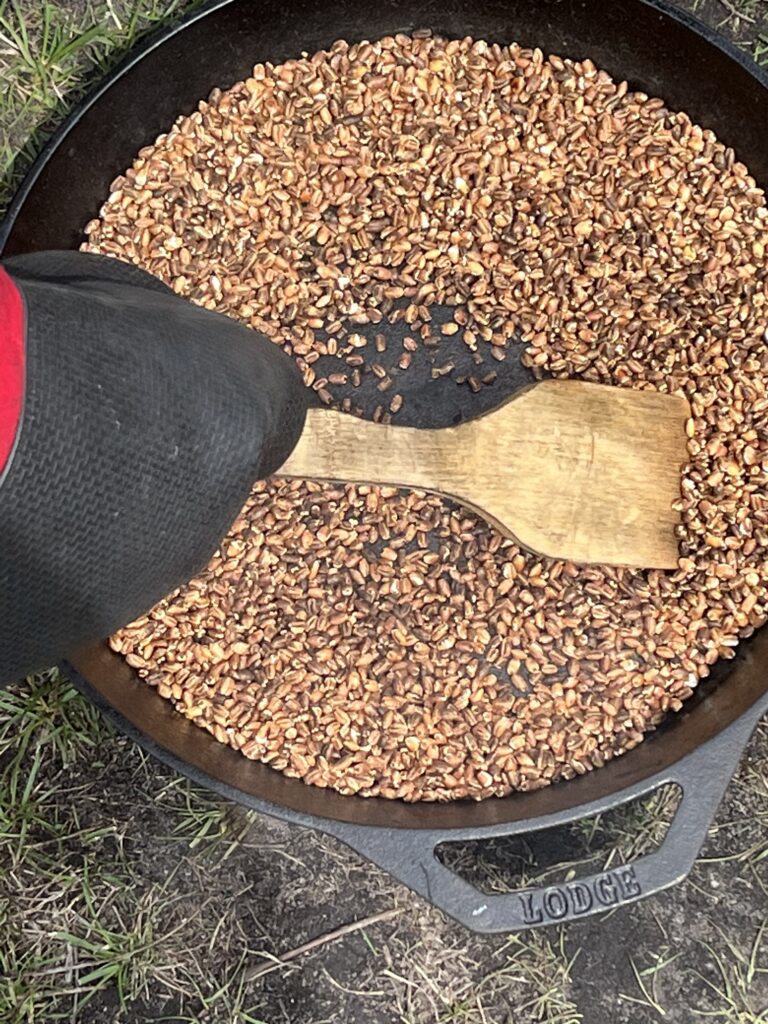
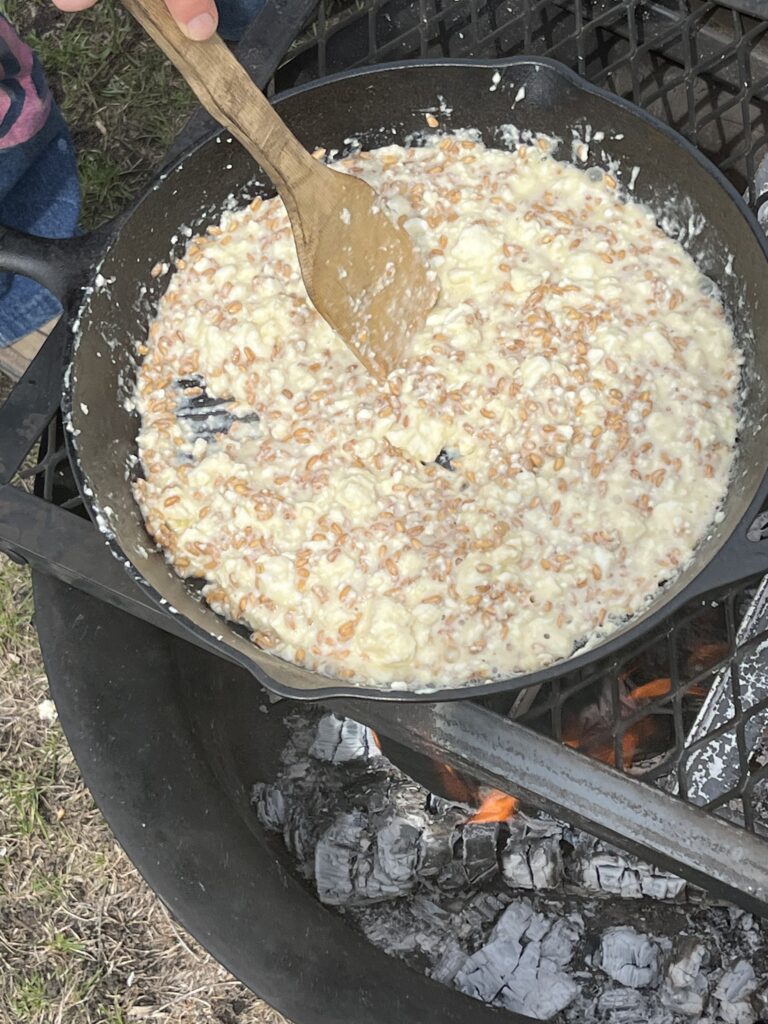
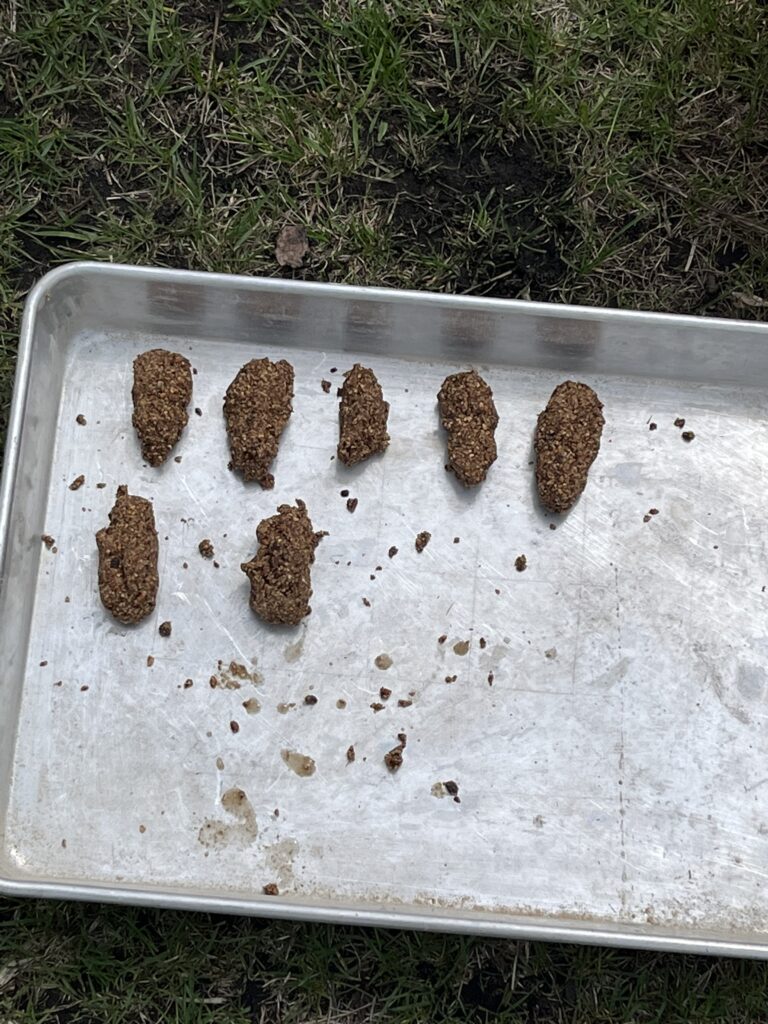
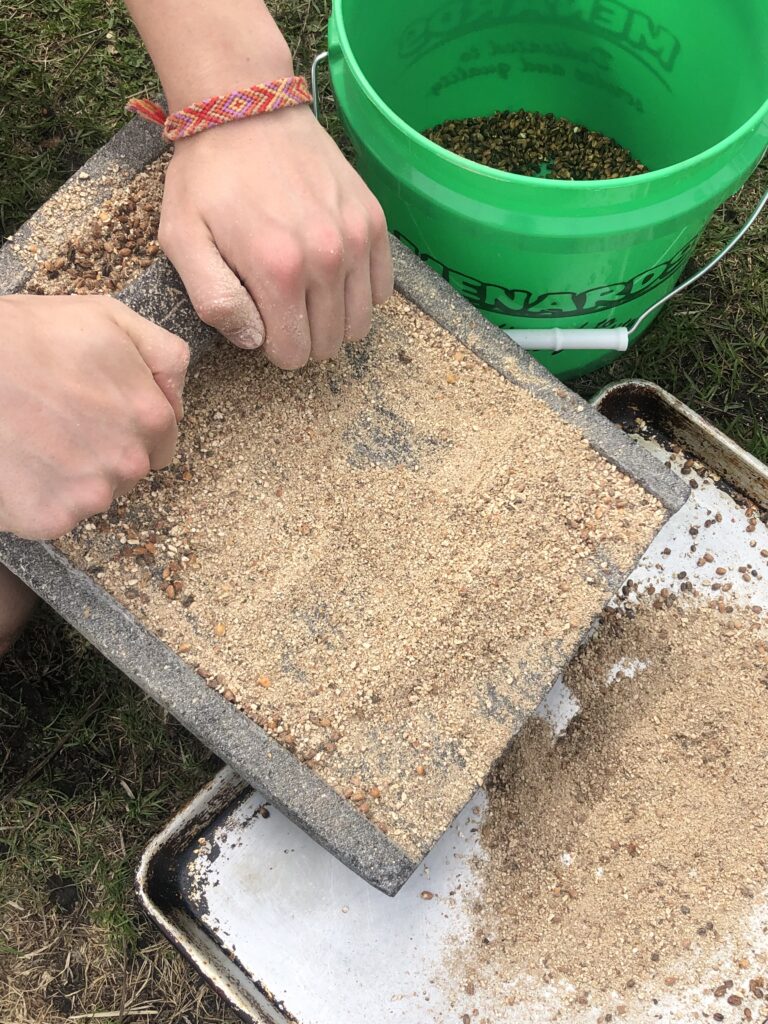

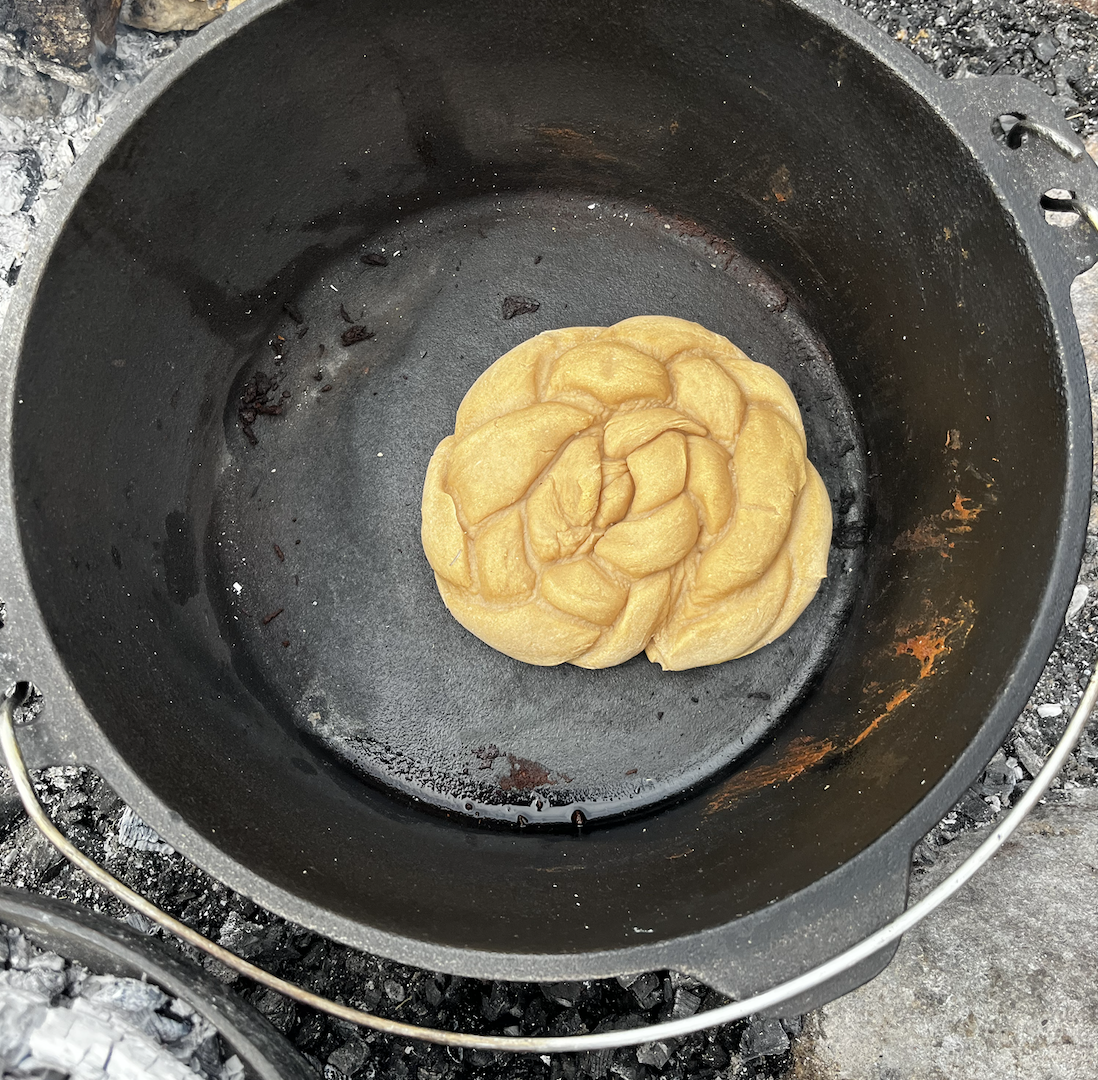
0 thoughts on “Lab Summary Week 7: Grain II”